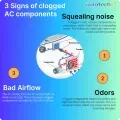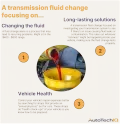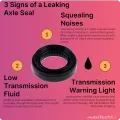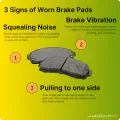
Beyond Digital Vehicle Inspection: What Many Auto Shops Miss
The advent of Digital Vehicle Inspections (DVI) revolutionized the auto repair industry, dramatically altering the dynamics between service providers and their customers. In today's digital age, consumers are accustomed to making purchasing decisions based on online research, be it for electronics, apparel, or home goods. They thrive on transparency, the convenience of accessible information, and the autonomy to weigh options on their terms, free from high-pressure sales tactics.
Yet, many auto repair shops are falling behind this new trend. Rather than improving the potential of DVIs to facilitate a customer-focused experience, they insist on aggressive phone pitches. More than ever, consumers want a comfortable buying journey; they would rather 'discover and decide' than be 'directed and dictated.'
A study for the AutoTechIQ certification process, which analyzed over 100 shops, highlighted five recurring issues:
- The Hand-off Ambiguity: When customers drop off their vehicles, the shop doesn't explain the subsequent steps clearly – both in terms of the timeline and the depth of the inspection.
- Lost in Translation: Even when inspection reports are sent to customers with proof images, they often lack context. Without explanatory guidelines, the customer has to decipher what the pictures and videos mean.
- Ill-timed Interactions: Service advisors often ring up customers at inconvenient moments. This feels intrusive and can set the tone of the conversation on a negative note, putting the customer on a defensive stand from the get-go.
- Overwhelming Info-Dump: During these calls, advisors flood customers with technical details, which feels like an aggressive sales tactic rather than a helpful consultation.
- Missed Opportunities: Post-service inspection results are rarely revisited. The results only serve when the vehicle is collected or prepared for a subsequent appointment.
Unfortunately, these observed issues highlight that a morning drop-off at a traditional service shop can quickly become a challenging customer experience. Customers feel in the dark, anxious about service updates and whether their vehicle will be ready by day's end.
Then comes the dreaded afternoon call: long and tiresome updates about the vehicle's status and any additional issues discovered during the complimentary inspection. In the lack of visual evidence – like the images and videos offered by DVI – these conversations become tense. Most customers, feeling cornered, often decline additional services.
But DVIs have the potential to switch this narrative. By sharing inspection results with images and videos detailing the vehicle's condition, repair shops can build trust and transparency. This streamlines the car owner's decision-making process and also establishes the service provider as a genuine ally in vehicle maintenance rather than a pushy salesperson.
Traditional Auto Repair vs. AutoTechIQ Approach: A Detailed Comparison
The insights gleaned from AutotechIQ's certification process uncovered a significant shift waiting to happen. Many auto shops transitioned from paper to digital inspections, but they did so without a thorough process update; they essentially inserted a modern tool into an old-school procedure. The real magic happens when shops recognize the nature of digital education in bridging the gap between them and their customers. Let's break down the previously mentioned issues and make a clear comparison between the old approach and the modern one.
Setting the Scene for the Customer
Old Process: After vehicle drop-off, customers went home or work without clarity on what to expect.
Modern Approach: The service advisor takes a proactive stance. They explain a sample digital inspection result, going through everything that the customer should anticipate. Additionally, they specify the timeframe in which the customer receives their tailored report, thereby setting realistic expectations.
Clarifying Visual Evidence
Old Process: Shops would attach images and videos, but these visuals often lacked context, requiring a follow-up phone call for clarification.
Modern Approach: Using photo and video editing tools, the service advisor creates guided visuals. These edited images and videos illustrate the vehicle's condition, highlighting the root cause of issues and suggesting treatments. For customers, an annotated image or video can be an educative experience, improving their trust and understanding.
Initiating Communication
Old Process: Service advisors would intrusively call customers, often interrupting them at inconvenient times.
Modern Approach: During vehicle drop-off, the advisor defines a time when the customer will receive the digital inspection report and encourages them to call for questions. Next, the advisor waits for a short window (like 20 minutes post dispatch) and only then considers reaching out if the customer hasn't responded.
The Nature of Phone Conversations
Old Process: Calls from service advisors were often overwhelming, flooded with complex information thrown at the customer.
Modern Approach: The conversation's tone shifts to be more collaborative. The service advisor becomes more of a consultant, addressing specific questions and clarifying elements of the digital inspection. This transforms the dynamic from a one-sided monologue to a two-way dialogue.
Utilizing Inspection Results for Future Engagement
Old Process: The primary aim was to "sell" services of the current shop visit using the inspection results.
Modern Approach: The service advisor chooses a longer-term view. Inspection results are reexamined during vehicle pick-up. Then, the advisor brings the inspection history to the next scheduled appointment. This reminds the customer of upcoming services and establishes a norm: every visit warrants a fresh inspection, promoting transparency and consistency.
Watch the short video below, which contrasts two experiences using a DVI.
For more information about the AutoTechIQ certification program, visit AutoTechIQ.com
Other news
-
Car is Squealing When Driving

-
What is Preventative Maintenance and What Are The Benefits of it?

-
JobViewIQ - DVI Process Training - Part of the Auto Care Alliance Benefits

-
7 Signs of Clogged AC Components

-
How Much Does a Transmission Fluid Change Cost?

-
7 Signs of a Leaking Axle Seal

-
8 Signs of a Bad Brake Pad
